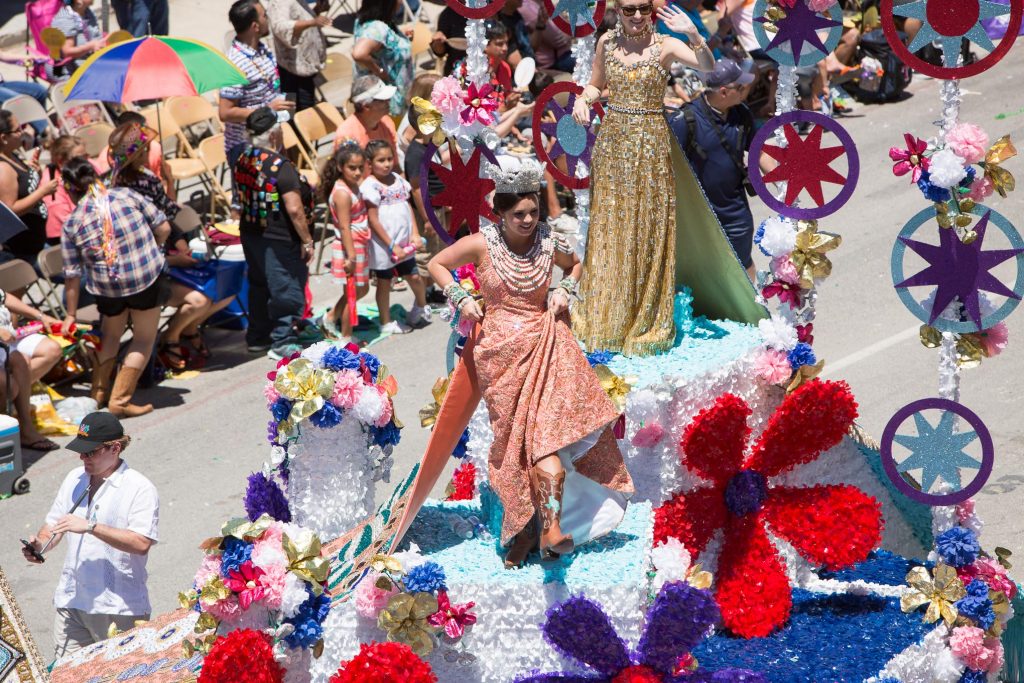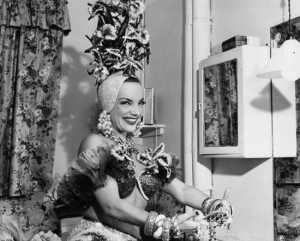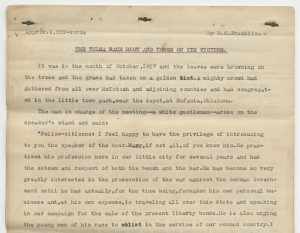Colorful floats; streets closed with barricades; people covering the sidewalks and setting up their lawn chairs to have a good view, having the day off from school; the Marching Bands from High Schools and Universities, decorating their instruments with ribbons, preparing their formation under Highway 37 on Grayson Street; the Fiesta Royalty putting on their best pairs of decorated shoes before stepping onto their throne, mounted on one of the biggest of the parade floats. If you’re a native San Antonian, you know exactly what grand celebration is about occur and what has been going on for the days before; it is part of Fiesta, the ten-day city-wide celebration; it is the Battle of Flowers parade. The Battle of Flowers is a 2.6-mile parade that runs through downtown San Antonio, typically one of the closing events of the Fiesta celebration. This Parades begins on the edge of downtown, and continues onto three major streets: Broadway, Alamo, and Commerce.1 Local schools participate in this parade; their dance troops, mariachi bands, ROTC, and Marching Band programs participate and walk the parade alongside the Texas Cavaliers, the Fiesta Royalty, and the Mayor. Although this annual event has become a hallmark for San Antonians, many don’t know how or when it all began. Let’s go back to its origins, back to the last decade of the nineteenth century in San Antonio.

Originating in 1891, the Battle of Flowers parade was created as a tribute to all those who fought and who fell at the Battles of San Jacinto and the Alamo.2 The idea of a grand celebration to commemorate these heroes came from a tourist, the native-Chicagoan W. J. Ballard. He believed that a proper tribute should be made, and asked a group of local ladies why this had not been the case just yet. His question extended through the city and made its way into newspapers and gained the approval of the community almost instantly. The anticipated idea aroused a spark of interest in Ellen Maury Slayden, a native Virginian elite, who had found her way to San Antonio by marriage to a merchant and later congressman, James L Slayden. Slayden then decided to bring Ballard’s idea to life, and since she knew it was almost impossible on her own, she decided to enlist the help of another newcomer to the area, J. S. Alexander. They both decided to take this on as a pet project of theirs, with the help and support of their husbands. Alexander, a banker before arriving in Texas, provided information on some familiarity he had had overseas about seeing a parade surrounded by flowers, where carts were decorated with flowers. Slayden also remembered similar instances in celebrations she knew about across Mexico and Spain, giving the basis for what the parade would become. The husbands, and many of the elite men of San Antonio, took over the project and had gentlemen speak on behalf of the ladies at the committee meetings; however, as the project grew, the ladies wanted to make sure that it was still a women’s project and continued to provide input and ideas, thus creating the Battle of Flowers Association.3

The parade was originally intended to be an April 21st celebration to celebrate the 55th anniversary of the victory of the Battle of San Jacinto; however, coincidentally, San Antonio was just then expecting its first-ever visit from the White House, the 23rd president of the United States, President Benjamin Harrison. As soon as word got out, the city became ecstatic and prepared a celebration to welcome the President, including moving the parade a day ahead of its original date. With the dates set in stone, the first official planning committee meeting took place only a mere seven days prior to the event. They were frantically trying to gather flowers from nearby towns, since San Antonio had just experienced some heavy rains, which had destroyed most flower gardens, leaving the city with a shortage of flowers just before the parade. Trains were rushed in with shipments of flowers from nearby towns. Other means of making up for the shortage were discussed as well, such as dressing the children up as flowers and having bicyclists decorate their mobiles with whatever blossoms they found and join the parade.4 In the days leading up to the parade, everything seemed all set to go, except for the weather. The city had been plagued with days of heavy rain, and the whole city was hopeful that the rains would cease as the day approached; however, they were wrong. On the morning of the parade, the rains didn’t have mercy on their plans, and as the President’s train arrived, the downpour became continuous. But the rains didn’t stop the city from providing the President with a warm welcome; however, it did postpone the flower parade for the following week, which, of course, would mean that the President would be long gone by then. When the warm weather finally arrived the following week, the parade went as planned; and it was so successful that the committee pushed to have it continue as an annual celebration. It has since been celebrated since 1891, except for the years during World Wars I and II.5

By 1985, the parade continued to grow into the week-long celebration known today as Fiesta. And as the years went by, Kings and Queens were elected as Fiesta Royalty.6 The Parade continues to grow, and so does its recognition across the city and the state. It is now funded by private associations. To this day the parade is one of the closing events of the city-wide, week-long Fiesta party and continues to generate community involvement. Every April, San Antonio puts on a fantastic show, and without a doubt, it all goes back to a Chicagoan tourist, two ladies, and one united community.

- Battle of Flowers, Official Website: Battle of Flowers About us (battleoflfowers.org, 2018). ↵
- Handbook of Texas, June 2010, s.v “Fiesta San Antonio,” by Mrs. Willard E. Simpson, Jr. ↵
- Jack Maguire, A Century of Fiesta in San Antonio (Austin, Texas: Eakin Press, 1990), 13-15. ↵
- Jack Maguire, A Century of Fiesta in San Antonio (Austin, Texas: Eakin Press, 1990), 17. ↵
- Jack Maguire, A Century of Fiesta in San Antonio (Austin, Texas: Eakin Press, 1990), 17; Laura Hernandez-Ehrisman, Inventing the Fiesta City, Heritage and Carnival in San Antonio (New Mexico Press,2008), 21. ↵
- Handbook of Texas, June 2010, s.v. “Fiesta San Antonio,” by Willard E. Simpson, Jr. ↵



117 comments
Ashley Martinez
I am from New Mexico and was not familiar with the Battle of Flowers. This was a very informational article, it provided all that I needed to understand this celebration and why it is significant here in San Antonio. The Battle of Flowers seems as though it is a beautiful and unique celebration that I hope to attend in the spring. San Antonio is rich in diversity and culture and the Battle of Flower’s is a great example of this.
Rosa Robledo Martinez
The battle of the flowers parade seems to be one of the most memorial things in San Antonio, but in reality not everyone knows the history of why we celebrate it. This article does a good job on explaining the background and history of the battle of the flowers. I am glad that San Antonio keeps the tradition alive and it keeps thriving more people are getting to know what our town is about.
Bruno Lezama
The San Antonio Battle of the Flowers is a parade that people from San Antonio celebrate every year; however, not everybody knows the history behind it. It is interesting how first it was originally intended to be an April 21st, the day of the anniversary of the victory of the Battle of San Jacinto. However, President Benjamin Harrison went to the first time to San Antonio. I believe that this is a good way to commemorate the people who fight in a battle. Great article!
Isabella Torres
It is really interesting how the parade grew so much over the years. It was unfortunate how the parade couldn’t happen while President Benjamin Harrison was visiting, but it did become an annual event. The parade has become an integral part of Fiesta and it definitely has a historically important background. Although I’m not from San Antonio, I have heard of Fiesta before; however, I didn’t;t really know about the Battle of the Flowers prior to reading this article.
Chelsea Alvarez
Having grown up two hours away from San Antonio, I had always heard about the Battle of Flowers but wasn’t too sure on what it was exactly. I really enjoy parades and love seeing different types of individuals come together in celebration. San Antonio is such a diverse city full of culture and history, so I enjoyed reading the history about how this event started. I can’t wait to experience this event for myself!
Averie Mendez
Interesting article. I just moved to San Antonio a couple months ago, and had never heard of the Battle of the Flowers parade so I’m very glad this article could educate me in its history and origin. It’s disappointing that the first arrangement of the parade had to be postponed due to the weather but I’m happy the city of San Antonio enjoyed the parade nonetheless.
Octaviano Huron
Great article. Even as a person from San Antonio who had actually marched in the Battle of Flowers parade for band in high school, I had never even known the history of the parade that I thought was so much fun. This article was very interesting to read in order to understand the culture of my city and how traditions of the parade have stayed constant or have altered over the years.
Sharriah Martinez
I, a San Antonio Native have been attending the Battle of Flowers Parade since I was a child. Fiesta here in San Antonio is treated as a holiday. Fiesta is a two week long event. It is crazy to think that as a San Antonio Native, from Texas I feel so uneducated. I remember learning about this in school but i honestly forgot. I was clueless to know this event originated from 1891. It was interesting to learn about Ellen Maury SLayden, the one who started all of this.
Joshua Garza
Battle of the flowers is great. I feel like I have such a close connection to my city during the parade every year. I look forward to it because it really gives you that sense of unity within the people who live on completely different sides of town but also call San Antonio their home. The only other time I feel really united is during the NBA playoffs when the spurs are playing.
Hali Garcia
I love this article. I am from a small town just south of San Antonio but my high school band would always want to march in one of the fiesta parades. I do not know a lot about the history of the Battle of the Flowers parade and I am glad that this article was written because now I know how the parade started. It never came across my mind that the parade could be in honor of the battles in Texas.